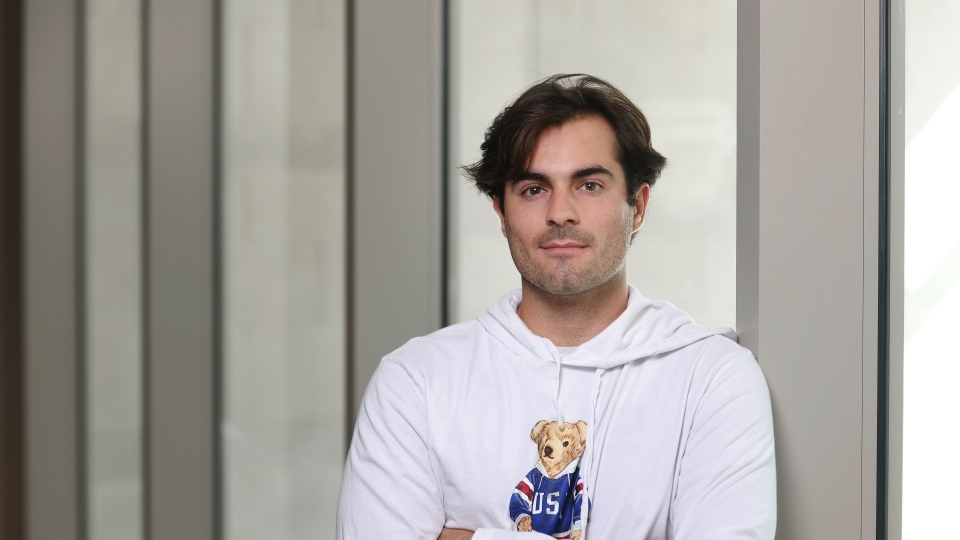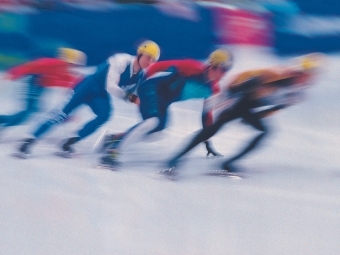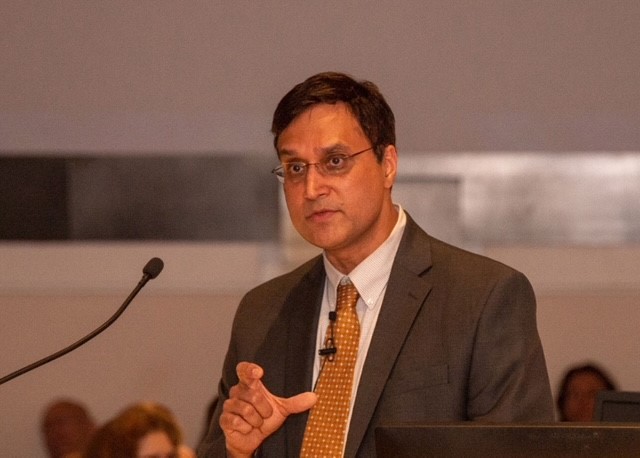Davidson Grad Steps Up to Help U.S. Olympic Committee Find Future Speed Skaters
February 16, 2022
- Author
- Jay Pfeifer

Owen Bezick ’21
When the Winter Olympics kicked off in Beijing, China, Owen Bezick ’21 tuned in from his apartment in Davidson, laptop computer at the ready. An unlikely expert in Olympic long-track speed skating, Bezick studied the sport during his senior year in the hope of helping the United States Olympic and Paralympic Committee (USOPC) enhance their talent pipeline.
Working with Tim Chartier, the Joseph R. Morton Professor of Mathematics and Computer Science, last spring, Bezick developed an analytic tool aimed at identifying promising young skaters.
The Question
The roots of this project stretch back a couple of years when Chartier and Dan Webb, lead analytics consultant for the USOPC, met at a conference at the Fields Institute, an international hub of mathematical research in Toronto. Meeting there is kind of like two Michelin-starred chefs meeting at Le Cordon Bleu—and Webb and Chartier immediately started cooking.
“There were a handful of professors that mentioned they were working on sourcing projects for student work,” Webb said. “And Tim was one of the ones that we moved forward with.”
Webb and the USOPC staff were hoping to capitalize on their strengths in data analysis to offset a deficiency in Olympic sports that have comparatively low participation in the United States.
Take speed skating, for example: The pipeline of young speed skaters in the U.S. is much smaller than in perennial medal-winner Nordic and Scandinavian countries. But that doesn’t mean the U.S. doesn’t have elite athletes. Some of the nation’s most-decorated Olympians are speed skaters. Eric Heiden won five golds in 1976 and 1980. Bonnie Blair, the most decorated female U.S. winter Olympian, won five golds and a bronze as she competed in four straight Olympics (1984-92). Shani Davis won gold in 2006 and 2010, and Erin Jackson just claimed a gold in the 500 meter event in Beijing.
But finding those promising skaters is a challenge. If the USOPC could provide a tool to help U.S. Speedskating identify them earlier—when they are still junior athletes—the speedskating organization could concentrate on developing them into medal-winners.
“We've been curious what we can learn from the junior data,” Webb said. “We wanted to see if there’s anything there that we can use to project future elite performance.”
And they wanted Chartier and a Davidson student to help answer that question.
Chartier, who helped found Cats Stats, the student sports analytics group, recognized the unique opportunity. So, he asked his colleagues in the Mathematics and Computer Science Department whether they knew a student who could handle the work and impress the USOPC.
Bezick’s name came back over and over again.
Already, he’d developed a reputation as an expert in data visualization and analysis.
Bezick had worked on interactive maps and dashboards for the College Crisis Initiative and developed Davidson’s Covid-19 dashboard that helped the community navigate the return to campus in fall 2020.
He also did some work through the Gig-Hub program at the Jay Hurt Hub for Innovation & Entrepreneurship, where he built data dashboards for a healthcare consultant. That work went so well that Bezick co-founded a software company called GatherWare before graduation. During his senior year, he and his partner’s pitch won the top prize in the 2021 Venture Fund competition, a $25,000 equity investment. He now works out of the Hurt Hub, building the new company.
Bezick brought more than just skill to the project however. He brought passion. Despite growing up in south Florida, Bezick had spent a lot of time on the ice as a skater and hockey player. Hockey was a family hobby. In fact, his younger brother is currently playing professional minor-league hockey in Amarillo, Texas.
When Chartier reached out, Bezick jumped at the chance.
“I was interested right away,” Bezick said. “It’s not too often you get to work with a group like the USOPC.”

The Problem
With the Davidson crew on board, the USOPC sent over about a half-million rows of data to digest.
“We gave them pretty much every international speed skating competition for the last 15 or 20 years,” Webb said.
Despite the scale of the data set, it didn’t include some of the most obvious-sounding competitive information. Basic building blocks like skaters’ race times were omitted.
“We actually didn't provide Owen a lot of speed skating-specific data,” Webb said. “We kept it very general with the idea that if there was something interesting that we learned, we hoped we could apply it to other sports or events as well.”
What the USOPC gave Bezick instead was a data set built on performance ratings that the organization uses in a number of Olympic events. If Bezick’s project was successful, it could be ported over to other sports.
But first: Bezick rolled up his sleeves.
“In a class project, we would get a very clean data set that has everything you need to make a nice, pretty model,” he said. “But in this setting, there's a lot of things that arise.”
The data was comprehensive but contained a host of overlaps or missing items. Some data stretched back to 2003 while the rest dated to 2008. Some senior athletes didn’t compete in junior events. Bezick had to make small adjustments by hand to get the data ready for analysis.
“A lot of people say they want to get into data analysis until they realize the majority of the time is just really gritty, dirty, data-engineering work that no one likes doing,” Bezick said.
Bezick then used an algorithm to divide senior-level competitors into five groups. The top-tier athletes were truly elite: Olympic medalists or high finishers. The second tier might have qualified for the Olympics, while the third, fourth and fifth never rose to distinction. Then, Bezick matched those competitors with their junior-level results and built a model based on their trajectories; trying to find patterns of success in the junior level that corresponded to the winning-est athletes.
Once he developed that model, he could turn it loose on current junior-level athletes to see which of today’s young skaters showed the same performance as the previous Olympic champions.
Then, Bezick added a signature flourish: interactive graphs.
“Owen answered the questions we provided and then he went above and beyond and took it in his own direction as well,” Webb said. “He built out an app that let us investigate the data and look for other kinds of correlations or patterns that we hadn't been able to before.
“It was a little bit outside of what we had asked for,” Webb said, “but it was a super-creative way to answer the questions.”
Bezick’s research didn’t uncover a hidden generation of future American medalist speed skaters, unfortunately.
“There was a little too much uncertainty in the data to get really specific answers,” Webb said.
But in research, getting any kind of answer is valuable. Bezick’s work will guide further USOPC research in new directions.
The experience also showed Bezick that data science could take him anywhere–from founding a business to scouting future Olympians.
“You're not confined to any sort of single field or any sort of place, because really you can take it as far as you want,” he said. “There's data for everything.”



